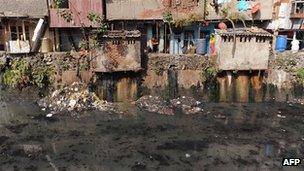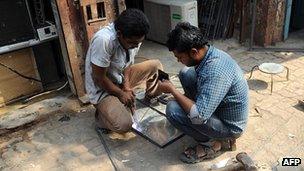Slum tourism: Patronising or social enlightenment?
- Published

Some residents of Dharavi live above pools of open sewage and have no access to clean water
There is a growing trend for tourists to seek out poverty-blighted neighbourhoods when they go on holiday, to get a sense of real life for the poorest communities there.
An increasing number of tourists are searching for something they cannot get at the top of the Eiffel Tower in Paris or the foot of the Statue of Liberty in New York.
This controversial trend has been dubbed "slum tourism".
Six years ago in India, Krishna Pujari and his British friend Chris Way began Reality Tours and Travel, to organise tours in Dharavi - arguably Asia's biggest slum.
Sitting on one of Mumbai's prime sites, Dharavi is the city's underbelly, where squalor mixes with enterprise.
The area is dotted with small businesses and recycling units, sitting alongside residential enclaves.
It produces goods worth $1bn ($620m) and a lot of its products are exported and yet, most of its one million inhabitants are impoverished and live in what the outside world may call inhuman conditions.
Dharavi is essentially a magnet for migrants from poor rural areas in other parts of the country, who travel to Mumbai to earn a livelihood for themselves and often for their family back home.
They are mostly garbage pickers, taxi drivers, manual labourers - the nameless, faceless people who keep a largely thankless city afloat.
Diverse opinions
"If you think this is just poverty, you will see that only," says Mr Pujari, "but in the poverty there is much to be learnt."
He tries to show a positive side of the slum, to people who think slums are just about poverty, danger or begging.
He explains how his company is a social business with 80% of all profits given to its sister organisation - the charity Reality Gives.
"We do we do this because a large percentage of our income is generated through the Dharavi tours and we felt that it was right to put most of the money back," Mr Pujari asserts.
Tourists do not see the organised slum tour as an example of exploiting poverty.
Florence Martina, a tourist from France, is not apologetic about touring Dharavi.
"These people are fighting against poverty, they are active in building some commerce and trade," she says.
Meanwhile, Christian Hansen from San Francisco says: "The most interesting thing is the working conditions of the people. I didn't expect them to be so industrial."
But local people say they do not benefit from slum tours.
"It doesn't help me at all," says Prasad, who is a trader in Dharavi.
"We see foreigners several times a week. Sometimes they come and talk to us, some offer us a bit of cash, but we don't get anything from these tours," he laments.
Wrong message
Not everyone is happy about how their city is portrayed to the outside world.
"The educated urban Indian is a tad sensitive about how certain attributes of Indian history, society and culture are portrayed in the western media," says Mumbai resident Hemanth Gopinath.

Some residents in Dharavi eke out a living by repairing household appliances
"The Oscar-winning film Slum Dog Millionaire, for all its success, was not well received by certain sections of the popular press in India," he recalls.
"And more recently, Oprah Winfrey drew a lot of flak for how, many felt, she was insensitive in her exchanges with a family in Dharavi," he notes.
He maintains that any criticism against the tour company in question, is that they highlight a negative aspect of the country to foreign citizens and also possibly engage in profiteering at the expense of the underprivileged.
"However, if they can positively impact even a minuscule section of the population of Dharavi, I would support it," he says.
Fatal attraction
What is it about the slums that attracts hordes of tourists each year?
Dr Malte Steinbrink at the University of Osnabruck in Germany, says: "We are currently witnessing a tremendous growth in slum tourism worldwide, especially in the global south."
He notes that the trend started in Victorian London over 150 years ago, when people from the London upper class were curious to see what happened in the East End.
In the global south it is a quite recent phenomenon - starting at the beginning of the 1990s in South Africa after the end of apartheid, when Nelson Mandela was released from prison.
"Tourists came to South Africa and wanted to see the townships and places of the apartheid repression and Mandela's house - so it began as a niche tourism for tourists with a special political interest," says Dr Steinbrink.
About 300-400,000 tourists a year visit the townships - between one-fifth and one-quarter of all tourists who visit South Africa.
"If we ask why slum tourism is on the rise at the moment, one could assume it is because there are more and more slums and more people who live in them worldwide," he says.
According to the World Tourist Organisation, one billion people are expected to travel in 2012, so the increase in the number of travellers opting for slum tourism is likely to rise.
- Published9 November 2010
- Published15 February 2012